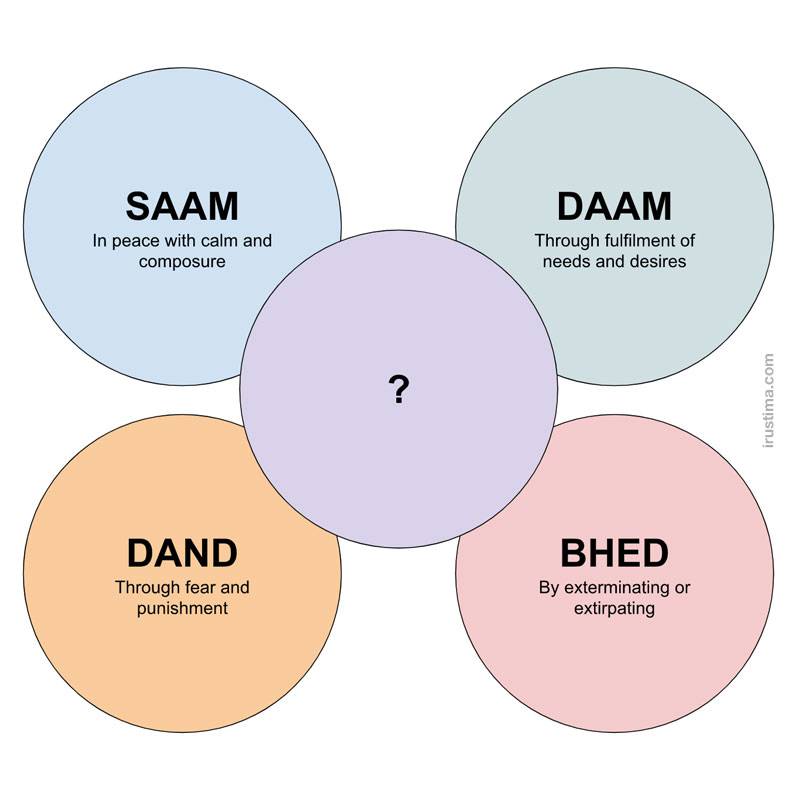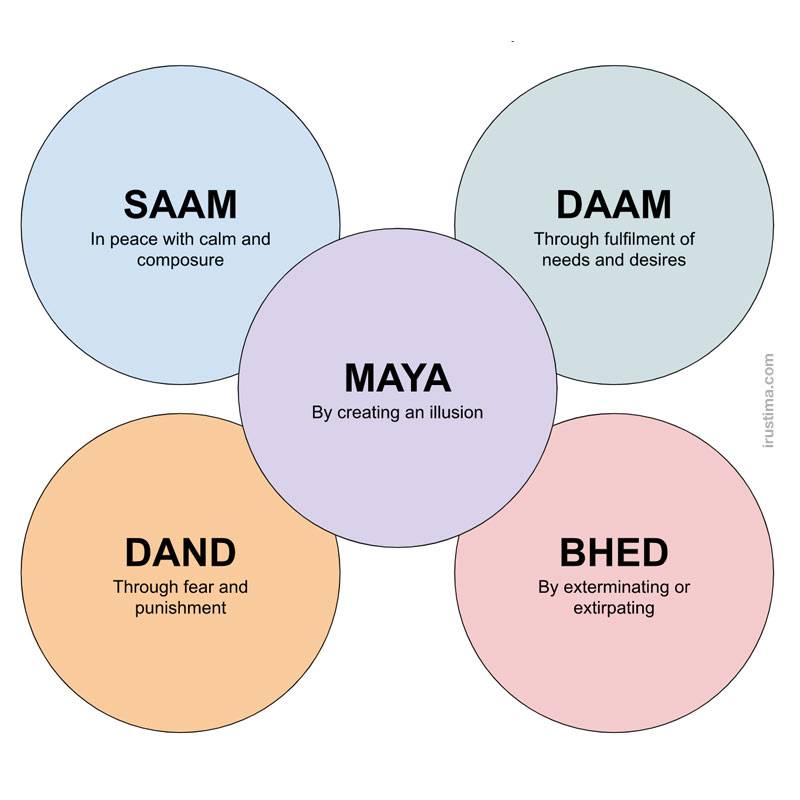
05 Oct The Role of ‘Maya’ in Negotiation
Negotiations are an integral part of our existence. We constantly negotiate with others and oftentimes, we may end up negotiating with ourselves. Though our main focus is on the dealings with others, some of us may realise the negotiations we do with ourselves through introspection and reflection. Thus, it is essential to have a robust framework for negotiations, one that holistically fulfils our purpose whatever that might be for each of us. Among the many frameworks available, Chanakya’s Neeti (Policy) of ‘Saam, Daam, Dand, Bhed’, explained in detail in his political treatise ‘Arthshastra’, has stood the rigour of time. However, in the 21st century it may be valuable to introduce the missing yet quite dominant element of ‘Maya‘ as well.
Before proceeding with the statement on ‘Maya’ as the fifth element in Chanakya’s Neeti (Policy) of ‘Saam, Daam, Dand, Bhed’, let us explore further the legendary Chanakya. We should also delve into the four components of the neeti ‘Saam, Daam, Dand, Bhed’ in greater detail. The understanding of both of these, the man and his neeti, will help with the need to establish ‘Maya’ as the fifth element in Chanakya’s Neeti.
The Historical Journey of the man
Chanakya (375–283 BCE) was an ancient Indian polymath who was active as a teacher, author, strategist, philosopher, economist, jurist, and royal advisor. He is traditionally identified as Kauṭilya or Vishnugupta who authored the ancient Indian political treatise, the Arthashastra. Chanakya is considered the pioneer of the field of political science and economics in India, and his work is thought of as an important precursor to classical economics. His works were lost near the end of the Gupta Empire in the sixth century CE and rediscovered in the early 20th century. Around 321 BCE, Chanakya assisted the first Mauryan emperor Chandragupta in his rise to power and is widely credited for having played an important role in the establishment of the Maurya Empire. Chanakya served as the chief advisor to both emperors Chandragupta and his son Bindusara.
Prior to the Chandragupta reign, the Nanda kings ruled many parts of Northern India. The Nandas were robbers-turned-rulers and they ruled their kingdom with an iron fist. They were well-built strong-bodied people. It was unfathomable to stand opposed to their sheer physical might. Chanakya was a Brahmin well-versed in the three Vedas and politics. As the learned subject of the state, he would comment on the matters of the state, which the Nanda kings would often find to be against their way of working. Why? The well-built strong Nandas ruled by the ‘Law of the Jungle’ where might was right. Chanakya was a scholar with certain bodily imperfections – a limp and a frail structure. Chanakya was inclined towards defining the ‘Law of Civility’, perhaps to protect the physically weak like himself or perhaps to keep the possibilities of a civil state alive. His various policies on civility, which extolled the power of the mighty ones to be curbed which in turn would have led to inclusivity of the weaker ones, did not go down well with the Nanda kings. Chanakya was threatened in the Nanda kingdom and to save his life he escaped from the Nandas by relocating far away to Taxila in Kashmir, where the Nanda Kings had little influence. Chanakya laboured the grudge against the Nandas. He survived in Taxila by teaching and spreading the written word carrying his perception of an ideal state which would be based on law and civility.
While Chanakya was in Taxila, the Nandas continued to expand their kingdom. Wars and conflict were never ending. Nandas were unpopular among their subjects not only because of their being lowly dacoits who rose to power by sheer might and deceit but also because of the excessive taxation they levied to fuel the state expansion. As they grew to be more and more powerful, their misconduct accentuated in equal measure.They maintained a harem of concubines and Chandragupta, the one who eventually overpowered the Nandas and thus ended their rule, is supposedly born of one of the concubines. While Chandragupta had royal blood, he would never be a King given his lineage on the maternal side. He grew under the shadows of the Nanda kings but he knew early on that he would never be the one in the line of succession. However, Chandragupta proved himself to be an able commander of the Nanda army, annexing provinces one after the other. The Nandas became increasingly uncomfortable with the growing popularity of Chandragupta. Chandragupta would mostly be fighting wars to find more wealth for the Nanda treasury. His conquests took him westwards towards Taxila, the place where Chanakya was waiting for him.
When the two, Chandragupta and Chanakya – the rebels, came together they planned to topple the Nanda king. At that time, Dhana Nanda was ruling the Nanda Empire. He was not as strong as his forefathers. Besides, the Nanda empire had become too big to be ruled peacefully. The constant opposition and rebellion bled the royal treasury and unsettled the people in the kingdom. Amidst the chaos, was the opportunity that Chanakya and Chandragupta, gradually over time, leveraged against Dhana Nanda to usher in the new era of rule based on civility and law as was conceived by Chanakya.
The Neeti of ‘Saam, Daam, Dand, Bhed’
To be a king requires forming formidable alliances. Alliances are made through negotiations. ‘Saam, Daam, Dand, Bhed’ is the policy to pursue negotiations effectively.
Saam (साम)
Saam means Calm & Composed. Saam Neeti is pursued in ways which are peaceful.
This primary approach of negotiation works by discussing the way work would be done through developing deeper knowledge and generating interest towards a common purpose. The basic skill required is the ability to Listen, Discuss, Educate, and Convince… in contrast to only Command, Argue, Assume, and Oppose. Saam requires us to let go of Pride. Pride hinders the essence of Saam. Saam also requires one to plead, persist, and if required, beg to prevail in pushing one’s purpose as the common goal of all involved.
Daam (दाम)
Daam means Price or Significance. Daam Neeti is pursued by putting a price to fulfil the needs and the desires.
When Saam may not be cutting the ice, Daam is of essence to move the negotiation forward. Daam is willingness to pay a price in order to convince a person. Daam may be monetary by nature, e.g. Gift, Bribe, Reward, Fee, Cost, Equity, etc; or can be non-monetary, e.g. Respect, Designation, Promotion, Recognition, etc. Daam acknowledges that people have need and greed which can be satisfied for participation towards one’s purpose as the common purpose of everyone involved.
Dand (दंड)
Dand means Punish. Dand Neeti is pursued by punishment and by creating fear.
Chanakya says “A king with rod becomes a terror; A king with mild rod is despised; A king just with rod is honoured”. Machiavelli said, “It is better to be feared than loved, if you cannot be both.” Long before Machiavelli, Tulsidas had said “भय बिन होय न प्रीत.” (Without Fear, there is no Love.)
Many people are convinced that when ‘Fear’ is used as an element of negotiation, it is bound to fail. It fails not because the person being punished has higher endurance or power but due to our inability to deploy Dand intelligently. Prior to pursuing Dand, we should:
- Exhaust all techniques of Saam and Daam
- Ensure no law or rule is broken
- Ensure the method deployed is in the right measure both in terms of its nature and quantity
- Access that one has the wherewithal to use Dand
Common elements of Dand are warning, intimidation, embargoes, curtailing liberties, disrespecting, pressurising by dominant coalition, etc.
Bhed (भेद)
Bhed means Exterminate or Extirpate. Bhed Neeti is pursued by using force with intent to humiliate, incapacitate or kill.
When none of the above methods work in the negotiation, Chanakya advises to choose the hard way forward, though this option is not encouraged at all. Dand should be pursued cautiously, especially against a mighty and stronger person lest it backfires with consequential damage to oneself. Bhed is sinistrous by nature. It works by spotting someone’s weakness and then attacking the person at his weakest points. Prior to pursuing Bhed,
- Deploy all techniques possible irrespective of whether it may be morally right or not
- Break laws and rules and make new rules to suit one’s purpose
- Deploy techniques in excessive measure, disproportionate in measure, both in their nature and in quantity
- Be prepared to win it all or lose everything
‘Maya’ (माया) integral to the Neeti
While Chanakya’s Neeti of ‘Saam, Daam, Dand, Bhed’ is a powerful tool for negotiation, there is an element that needs to be added to retrofit the policy for contemporary times. The element of ‘Maya’, now ubiquitous and popular, befits the inclusion.
Maya means Illusion. Maya Neeti is pursued by creating an illusion with the intent to awe or mislead.
While the first two elements of the neeti – Saam and Daam – exist within the ‘Law of Civility’, the other two components – Dand and Bhed – are functions of the ‘Law of the Jungle’. Oftentimes, the ‘Law of the Jungle’ is the best solution in scenarios when the ‘Law of the Civility’ fails to bear fruits and continues unending anguish over a long period of time. The ‘Law of the Jungle’ is detrimental for all the parties including the aggressor but it is the tactic to stand as the winner among the losers.
The morality of associating with Dand and Bhed puts the executioner in a bad light, unless ‘Maya’ is deployed effectively. Maya is the technique to use ‘Dand and/or Bhed’ under the pretence of ‘Saam and/or Daam’, and vice versa. It is enforcing the ‘Law of the Jungle’ masquerading as the ‘Law of Civility’ and vice versa. Here are a few examples:
- Faking – Spreading fake-information as truth with the intent to benefit one person over another, e.g. fake it till you make it.
- Facading – Creating an image of grandeur, e.g. selling ULIP/Insurances as investment products, misleading advertisements, etc.
- Addicting – Using human psychology against humans in order to make them addicted to products & services, e.g. social media, ‘Sale’ seasons etc.
- Scamming – Promising big but delivering little or nothing, e.g. phishing, spam-calls, etc.
- Subterfuging – Giving freebies or deals to collect something else without knowledge of buyer, e.g. collecting data of users/buyers.
- Feigning – Pretending to be the victim when one is not.
- Loopholing – Making clauses in law and agreements which can be interpreted as per the convenience of the executor.
- Masquerading – Showing a make-believe face and hiding the true identity or purpose.
- Camouflaging – Hiding among the crowd or merging with the dominant coalition to avoid being noticed for one-on-one engagement.
Summary
With the rapid normalisation of ‘Maya’ in societies world over and its acceptability by the masses who are under a spell of illusions, I, without being judgmental of Maya-jaal (The web of Maya) being right or wrong, propose ‘Maya’ to be included in Chanakya’s Neeti. ‘Maya’ is the underground tunnel that connects our idealism in our pursuit of civility to our primordial need to survive in the jungle at any cost. Let ‘Maya’ help in negotiation before Dand or Bhed are deployed.
“Saam, Daam, Maya, Dand, Bhed”
Chanakya Negotiation Policy
remodelled for the 21st century

My sincere thanks to Sudip Bajpai (Faculty of English, CAT Mentor, Interview Prep Guide) for editing the article, and saving me the embarrassment of the many language mistakes (spelling and grammar) I had made.
If you liked this post, then you may consider reading The General Theory on Fitness , The General Theory on Finance , and Creating A Personal ‘Learning Ecosystem’ also



No Comments